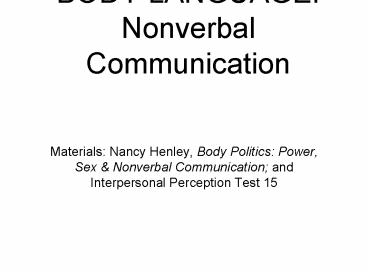BODY LANGUAGE: Nonverbal Communication BODY LANGUAGE: Nonverbal Communication - PowerPoint PPT Presentation
1 / 31
Title:
BODY LANGUAGE: Nonverbal Communication BODY LANGUAGE: Nonverbal Communication
Description:
Bodily language is crucial for our performance. ... it and threw crumbs for the birds pecking near their feet, sparrows, pigeons. ... – PowerPoint PPT presentation
Number of Views:670
Avg rating:3.0/5.0
Title: BODY LANGUAGE: Nonverbal Communication BODY LANGUAGE: Nonverbal Communication
1
BODY LANGUAGE Nonverbal CommunicationBODY
LANGUAGE Nonverbal Communication
- Materials Nancy Henley, Body Politics Power,
Sex Nonverbal Communication and Interpersonal
Perception Test 15
2
Bodily language is crucial for our performance.
- Nonverbal communication refers to how we say
things with our body postures and movements,
facial expressions, gestures, touching, eye
contact, use of space and so on. - many channels or areas of expressing body
language. - Examples
3
- verbal and nonverbal communication are combined
to form a message - Lying Ekman 10,000 expressions in The Facial
Action Coding System combinations of 43
independent muscles in the face, Clinton infamous
statement - Search for machines Polygraph (William Moulton
Marston)
4
(No Transcript)
5
(No Transcript)
6
- In Most interactions, each of us plays both the
role of encoder and role of decoder. produce
communications (verbal and nonverbal) directed at
others (encode). And we interpret, decode. - We use these cues to form impressions and reach
conclusions about others, a remarkable feat,
because in any interaction, hundreds or even
thousands of verbal and nonverbal cues stream by
us, vanishing in milliseconds.
7
- discard most cues, seizing on the few e.g. a
momentary facial expression, a vocal inflection,
a fleeting gesture, that tell us what the other
person means or is feeling - We can recognize a persons facial expression of
emotion from as little as l/24th second exposure,
and it is often possible to interpret other
peoples behavior, feelings,and relationships from
something as simple as a photograph.
8
- Because our culture considers trivial, ignores
and doesn't educate its members to nonverbal
behavior, it constitutes a vague stimulus
situation. Its interpretation is then highly
susceptible to social influence which further
maintains the status quo.
9
Henley 9 different areas of bodily expression.
- Body Language expresses one's social role. They
are the front stage performance of the role.
Bodily language reinforces social status, part of
the decorum part of the performance - Goffman's theme is the performance Every social
situation is a drama. Bodily communication
amplifies performance,
10
- More than the arrangement of facts, there is an
interpretation of facts. - Goffman would look for nonverbal communication to
convey other's belief in the part one is playing.
11
Emersons three themes
- We look at activity to learn its theme its
frame what is really going on. Nonverbal
communication occurs in her three areas
12
- The Setting,
- Language,
- Demeanor
13
setting
- Goffman emphasizes the context that lets us see
the meaning of the factual arrangement. - Cues are given off that help us develop the
frame, how people use space or territory and time
14
- Props are key to a setting, explicitly part of
the body language, toying with objects, looking
at them, having them in the background, give off
cues as to what is going on, how people use them
toying with an object suggeststs to the DA, who
done it - Goffman refers to them as Sign equipment
- the props that aid the performance, they are
appropriate, e.g. Carrying a briefcase for
professor.
15
- Space proxemics how close we are to each other
Reflects Intimacy, solidarity or power - Body language is not only individual, it is
interactive.
16
- several ways we use space and time, as a
continuum. different contexts, reflecting
different uses of space amounts of time - 1) public time asking directions, checking out
library books how space used here? - 2) social time, making purchases, inquiring about
services - 3) personal time job interviews, doctors and
dentists appointments - 4) intimate time close family interactions and
gatherings.
17
- Proxemics how we use personal space. Intimate
distance 0-18 inches, nonpublic interactions,
such as comforting too close for asking
directions - personal distance 1.5- 4 feet people who are
bonded, discussions with others - social distance 4-12 feet, formal business and
social discourse - Public distance 12-25 feet too far for party
18
Demeanor
- Goffman refers to Expressive Cues. we use
expressive cues to send and receive thoughts and
feelings. - Ranking, hierarchy, height
- Touch who can touch whom? We have status ridden
society - Gesture, Posture
- Eye contact
- Facial expression
19
- Facial expression
20
The standards
- Require individuals to show respect for the
region and setting one is in, to impress the
audience or avoid sanctions. - There are a number of fronts for our acts,
- The front stage is where the performance is
given. - The actor's performance in the front region gives
the appearance that the activity here maintains
and embodies certain standards
21
- Activity occurs in the presence of other persons,
i.e. in the front region, some aspect of the
activity are expressively accentuated and other
aspects might discredit the fostered impression
are suppressed.
22
- Take the following description of a couple
having an affair, overseen by a common friend
that did not know until that moment when he spied
their back stage behavior that they were surely a
close couple. Their Body Language revealed that
they were lovers in secret Last Orders
23
- From the front of the van I could see them
clearly, fifty yards, ten o'clock, Ray on the
side of the bench nearest me. It seemed to me
that though they made the shapes of two separate
people, sitting on the same bench, so you might
have thought it was just a chance encounter, they
also made a single shape that was the two of them
together. Ray leant forward and lit a cigarette,
cupping his hands against the breeze. Then he
took a puff, took the cigarette from his mouth
and with the same hand, elbow on knee, stroked
his bottom lip with his thumb. There was a paper
bag wedged between them with the remains of
something, because Amy dipped her hand into it
and threw crumbs for the birds pecking near their
feet, sparrows, pigeons. She did this quickly,
with a jerk of her arm, as if she half wanted to
shoo the birds away, not fed them, but the crumbs
kept them coming back. Ray didn't feed the
birds. He smoked and rubbed his lip and
scratched his neck. Then he sat back and at that
exact moment Amy leant forward as if they were a
machine that worked like that. She stroked her
leg just below the knee as if she had an ache
there.
24
- Vertegaal from Queens U. on eye gaze, a strong
link between the amount of eye contact people
receive and their degree of participation in
group communications.
25
paraLanguage
- not the meaning of the words we say, but to how
we say them the rhythm, pitch, intensity,
nasality, slurring, etc. - Who controls the conversational flow?
- Self disclosure
- tone
26
Power
- Why does nonverbal behavior cement power?
- Power (status, dominance) is a major topic of
nonverbal communication, and nonverbal behavior
is a major avenue for social control on a large
scale, and interpersonal dominance on a smaller
scale. - nonverbal power gestures provide the
micropolitical structure, the thousands of daily
acts through which nonverbal influence takes
place, which underlies and supports the
macropolitical structure.
27
- Many nonverbal behaviors have the dual function
of expressing either dominance or intimacy,
according to whether they are asymmetrically, Or
symmetrically used by the partners in the
relationship.
28
Interpersonal Perception Task 15,
- WE DID NOT SHOW THIS IN CLASS
- The scenes were about behavior,
- look not only to identify the right answer, but
figure out why you choose it - Identify what kinds of cues are found in
nonverbal communication that are unavailable in
words alone?
29
Items
- facial expressions
- words, tones, hesitations
- eye movements
- gestures,
- personal space
- posture and touching. occur simultaneous, as in
real life.
30
5 categories of interaction
- 3 scenes for each
- status,
- kinship
- intimacy
- competition
- deception
31
- Going to ask you to choose between A and B, or
sometimes both. you can guess because the issue
is that we are attuned to cues that we in
everyday life guess at. - Then think about what it was, words or nonverbal
communication that led to the answer, - silent cues are powerful. We remove sound, but
other cues visible.































